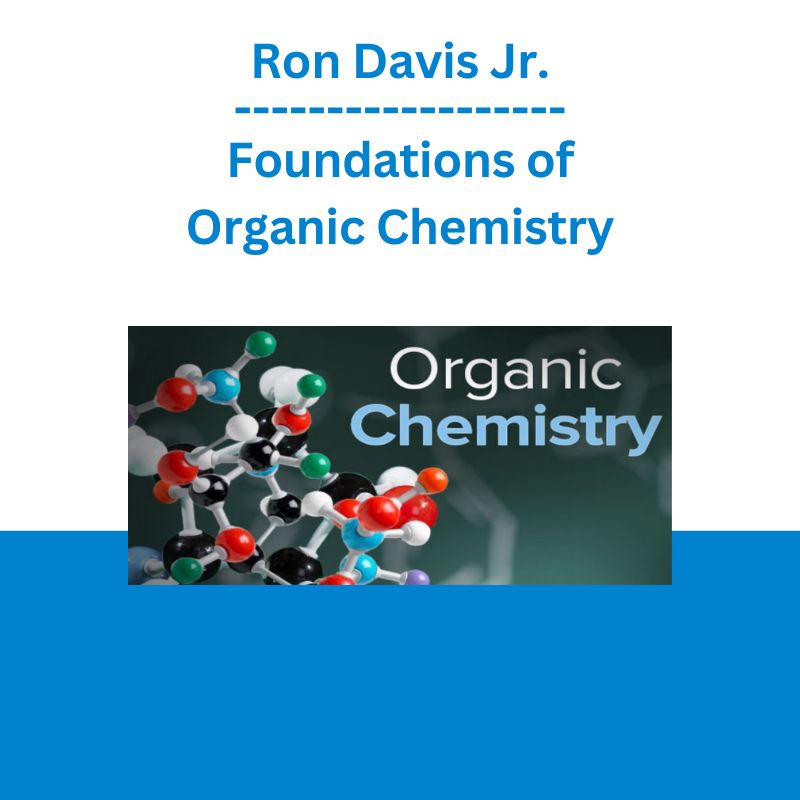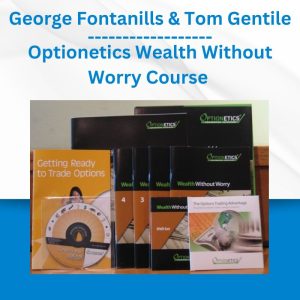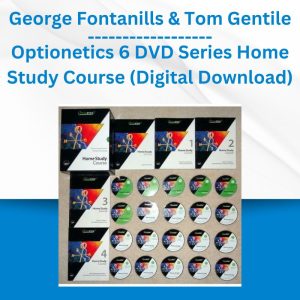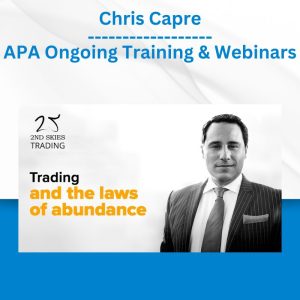*** Proof of Product ***
Exploring the Essential Features of “Ron Davis Jr. – Foundations of Organic Chemistry”
Foundations of Organic Chemistry
Organic chemistry-one of science’s most complex fields-is finally made clear with this richly illustrated introductory course taught by an award-winning professor.
LECTURE (36)
01:Why Carbon?
Start exploring organic chemistry’s foundations with a review of the basic science of chemistry (including atomic structure and the periodic table). Then, get an engaging introduction to organic chemistry: its origin, its evolution, its relationship to carbon, and its fascinating applications in everything from food to fuel to medicine.
02:Structure of the Atom and Chemical Bonding
Take a more detailed look at atomic structure and chemical bonding. What exactly drives an atom’s desire to bond? What are the differences between ionic bonds, covalent bonds, and polar covalent bonds? How does the hybridization of atomic orbitals work, and how does it explain the complex geometries of carbon frameworks?
03:Drawing Chemical Structures
Investigate some of the key methods scientists employ to communicate the right structural information about molecular compounds, including their identity, the ratio of elements that comprise them, and their connectivity. Methods you’ll explore include Fischer projections, Newman projections, and stereoimages-all of which help us overcome the challenges of conveying the three-dimensional positions …
04:Drawing Chemical Reactions
You’ve learned how to depict molecules as they exist at a single point in time. How about as time passes? The answer: much like a cartoonist. Here, learn about this scientific art form, including writing reaction schemes, expanding them into elementary steps, using curved arrows to chart molecular progress, and more.
05:Acid-Base Chemistry
Focus on the first of several fundamental classes of reactions you’ll encounter throughout this course: the proton transfer reaction. You’ll learn the three classifications of acids and bases; the Arrhenius, Bronsted-Lowry, and Lewis definitions; how chemists predict proton transfer reaction outcomes; two kinds of intramolecular proton transfer reactions; and more.
06:Stereochemistry-Molecular Handedness
Make sense of a crucial concept in organic chemistry: the handedness of molecules, or, as chemists call it, “chirality.” Topics include the definition of chiral tetrahedral centers; the creation of stereoisomer sets via inversion of handedness; and intriguing examples of stereoisomers (including enantiomers and double-bonded stereoisomers) and their unique chiral centers.
07:Alkanes-The Simplest Hydrocarbons
Start examining various classes of organic compounds with alkanes, whose hydrocarbons consist entirely of hydrogen and carbon. How can a few simple carbon atoms lead to millions of possible alkane structures? How does structure affect their physical properties? And what curious role did they play in 19th-century whaling?
08:Cyclic Alkanes
Turn now to cyclic alkanes, in which the closing of a loop of carbons forms a whole new class of alkanes with properties all their own. As you learn more about this new class of hydrocarbons, you’ll cover the phenomenon of ring strain, the equilibrium between chair conformers, and bicyclic hydrocarbons.
09:Alkenes and Alkynes
How can pi bonds change the chemistry of hydrocarbons? How did one of the greatest rivalries in chemistry lead to an understanding of trends in stability among regio- and stereoisomers with the same molecular formula? Why do terminal alkynes have such unusual acidity? Professor Davis has the answers to these and other questions.
10:Alkyl Halides
Explore alkyl halides, hydrocarbons where one or more hydrogen atoms are replaced by a halogen atom. You’ll examine how larger halogen atoms decrease the volatility of alkyl halides compared to their alkane counterparts (which radically changed the science of refrigeration). You’ll also learn about the reactivity of alkyl halides and the phenomenon of carbocation rearrangements.
11:Substitution Reactions
Investigate substitution reactions: one of the fundamental mechanisms by which one compound becomes another. The simple molecules you’ve encountered so far can be altered in targeted ways and once you understand how these reactions work, Professor Davis says you’ve reached “a palpable threshold in the study of organic chemistry.”
12:Elimination Reactions
Cover the second class of organic reaction: eliminations, the primary method for producing alkenes. As you’ll learn, elimination reactions proceed with the production of a byproduct formed by the leaving group; in contrast to substitution reactions, they involve a significant increase in entropy because they make more molecules than they consume.
13:Addition Reactions
Complete your mastery of the trifecta of fundamental organic reactions with a lecture on addition, which adds new groups to unsaturated molecules by sacrificing pi bonds for more stable sigma bonds. You’ll explore the basics of addition reactions; the hydrogenation of alkenes and alkines; the ways addition has helped create food additives; and much more.
14:Alcohols and Ethers
In this lecture, consider the important role of oxygen in organic chemistry. Among the topics you’ll learn about here: the oxygen atom in sp3 hybridization states; techniques for synthesizing alcohols and ethers; and methods for activating alcohols into more reactive leaving groups (specifically sulfonate esters, phosphinate esters, and tosylates).
15:Aldehydes and Ketones
Continue exploring oxygen’s role in organic chemistry. Here, Professor Davis introduces you to the properties and reactivity of two simple carbonyl compounds: aldehydes and ketones. What do we know about these oxygen-containing compounds and their chemistry? And what’s their curious connection with how you feel after a night of heavy drinking?
16:Organic Acids and Esters
Carboxylic acids and esters are two oxygen-containing compounds that possess multiple oxygen atoms with different hybridization states. First, look at two ways to prepare carboxylic acids. Then, examine how Fischer esterification produces esters. Finally, learn about retrosynthetic analysis, a tool that helps organic chemists address synthetic challenges.
17:Amines, Imines, and Nitriles
Turn now to nitrogen, which has played an important role in the chemistry of life since it began. Learn the chemistry of primary, secondary, and tertiary amines, the simplest of nitrogen-containing compounds. Also, consider imines (containing a pi-bond to nitrogen) and nitriles (where two pi bonds are present), including the simplest and most well-known nitrile: hydrogen cyanide.
18:Nitrates, Amino Acids, and Amides
Nitroglycerine, dynamite, TNT. What do these explosives have in common? They all contain highly reactive compounds that combine nitrogen and oxygen in organics. Look closely at these and other materials in this in-depth lecture on functional groups containing nitrogen and oxygen that covers everything from nitrate esters to trinitrotoluene to amino acids.
19:Conjugation and the Diels-Alder Reaction
Start by examining the phenomenon of conjugation involving multiple, resonating pi bonds and the extra stability that they endow on organic compounds. Then, explore two reactions (including one that resulted in a Nobel Prize) involved in conjugated diene reactivity. Finally, spend some time investigating the relationship between frontier molecular orbits and thermally activated reactions.
20:Benzene and Aromatic Compounds
Get better acquainted with benzene and a class of compounds known as aromatics, as well as the role aromaticity plays in dictating the acid-base properties of organics. Also, learn about polynuclear aromatics, buckminsterfullerenes, carbon nanotubes, and carbon fibers-all at the forefront of cutting-edge research going on in labs around the world.
21:Modifying Benzene-Aromatic Substitution
Build on your understanding of aromatics by investigating a very useful class of reactions: electrophilic aromatic substitution. What’s the general mechanism by which these reactions occur? What are some of the many modifications chemists can make to benzene-and how can these already modified benzenes be further modified? What role did this reaction play in the synthesis of one of the most infamo…
22:Sugars and Carbohydrates
Start taking a more biologically oriented look at the foundations of organic chemistry by investigating compounds known as carbohydrates. Examine Fischer projections of their two main classes, aldoses and ketoses; learn how cyclic sugars help create disaccharides and polysaccharides used in everything from fruit preserves to body armor; and more.
23:DNA and Nucleic Acids
Professor Davis introduces you to ribose, the central component of both RNA and DNA. Starting from individual molecules and motifs, you’ll progressively work your way up toward a full model for the structure of the sub-units involved in our genetic code. This lecture is proof of organic chemistry’s powerful role in establishing who you are.
24:Amino Acids, Peptides, and Proteins
Proteins make up 20 percent of your body’s mass. They mediate almost every chemical reaction in the human body, and they’re found in everything from medicine to detergents. Here, make sense of the intricate, beautiful structures and interactions of proteins. Also, take a peek at how they’re created in labs for further study.
25:Metals in Organic Chemistry
Probe the connections between biology and metals with this lecture on some compounds and reactions in the field of organometallic chemistry. As you’ll quickly learn, organometallics have a range of practical applications; one example you’ll encounter is Dotarem, an organometallic compound used to help detect tumors in cancer patients.
26:Synthetic Polymers
Complete your survey of organic compounds with the largest organic molecules of all: polymers. To better understand this versatile class of compounds, you’ll learn about the two general classes of polymers (addition and condensation), how they’re designed, and how they’ve changed the world (one example: vulcanized rubber).
27:UV-Visible Spectroscopy
How do organic chemists actually prove the behavior of molecules and chemical structures you’ve learned about in the preceding lectures? The answer: spectroscopy, which entails the observation of the interaction between matter and light. In the first of several lectures on the topic, focus specifically on observations made with the UV-visible spectrum.
28:Infrared Spectroscopy
Transition to the other side of the visible spectrum and discover how infrared spectroscopy provides chemists with different information about structures. In doing so, you’ll come to see molecular structures in a new light: not as rigid constructs but as dynamic, vibrating frameworks with bonds that can stretch and bend.
29:Measuring Handedness with Polarimetry
Continue your in-depth look at spectroscopy with a focus on the plane polarization of light, and the ability of chiral molecules to rotate plane-polarized light. Who discovered this scientific phenomenon? How is it observed, and with what specific tools? Find out in this lecture that deftly blends science and history.
30:Nuclear Magnetic Resonance
Visit the radio portion of the electromagnetic spectrum for insights into how tiny, atom-sized magnets in organic molecules interact with radio waves (and each other) to produce a complex set of magnetic resonances-which are one of the gold-standard identification tools used in modern organic chemistry. Topics include Zeeman splitting, magnetic spin-spin coupling, and multiplets.
31:Advanced Spectroscopic Techniques
In this final lecture on spectroscopic techniques, discover the importance of modern NMR spectrometers, which use superconducting magnets and radio receivers to collect spectra with more speed and precision (and in different ways) than other techniques. Also, get an intriguing lesson in the human element-and limitations-involved in spectroscopy.
32:Purifying by Recrystallization
How are organic materials purified for both study and practical use? One staple technique is recrystallization, which relies on the tendency of organic molecules to form highly ordered crystals. Topics here include the effect of impurities on organic crystalline solids; the phenomenon of incongruent melting; and more.
33:Purifying by Distillation
Another purification method is distillation, used for producing potable water, refining oil, and more. First, examine the fundamental laws governing this influential chemical technique. Then, get a closer look at distillation apparatuses commonly used for vaporization and condensation. Finally, learn about azeotropes-mixtures of liquids that are impossible to distill.
34:Purifying by Extraction
Discover how solubility makes for an extremely effective tool for isolating non-volatile organic compounds through liquid-liquid and solid-liquid extractions (part of a larger phenomenon known as partitioning). As you delve into these processes, you’ll learn one way to better understand extractions: making a perfect cup of tea.
35:Purifying by Chromatography
Chromatography-in which partitioning between stationary and mobile phases leads to predictable rates of movement for compounds-is one of the most powerful separation techniques ever developed. And, when done properly, it allows chemists to isolate almost anything they can imagine. Witness a technique at the core of Professor Davis’s laboratory experience.
36:The Future of Organic Chemistry
Finish the course by peering into the future of this fascinating field. How can groundbreaking chemical advancements help us stave off global famine-and even help us live on other planets? By exploring questions like these, you’ll truly understand how organic chemistry can help us build a better world.
DETAILS
Overview
Every living thing on Earth uses carbon as a basic building block. Yet organic chemistry-the study of carbon-containing matter-is feared by many interested learners. Making this field relevant and graspable is the forte of Professor Davis. Combining years of classroom and lab experience, he’s crafted vibrantly illustrated lectures designed for everyone seeking to understand this challenging, fascinating subject.
About
Ron B. Davis Jr.
I hope this contributes to a lifelong journey exploring and appreciating the rich and beautiful chemistry of life and our world.
ALMA MATER
Pennsylvania State University
INSTITUTION
Georgetown University
Dr. Ron B. Davis, Jr. is an Associate Teaching Professor of Chemistry at Georgetown University, where he has been teaching introductory organic chemistry laboratories since 2008. He earned his Ph.D. in Chemistry from The Pennsylvania State University. Prior to teaching chemistry at the undergraduate level, Professor Davis spent several years as a pharmaceutical research and development chemist. Professor Davis’s research focuses on the fundamental forces governing the interactions of proteins with small organic molecules. His research has been published in such scholarly journals as Proteins and Biochemistry and has been presented at the Annual Symposium of The Protein Society. He also maintains an educational YouTube channel and provides interviews and content to various media outlets, including The Discovery Channel. At The Pennsylvania State University, Professor Davis received a Dalalian Fellowship and the Dan Waugh Teaching Award. He is also a member of the Division of Chemical Education of the American Chemical Society.
Please see the full list of alternative group-buy courses available here: https://lunacourse.com/shop/










 Jesse Livermore Trading System - Joe Marwood
Jesse Livermore Trading System - Joe Marwood